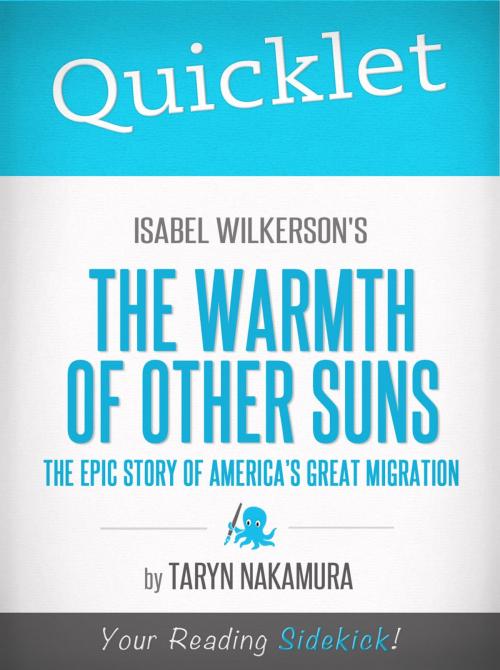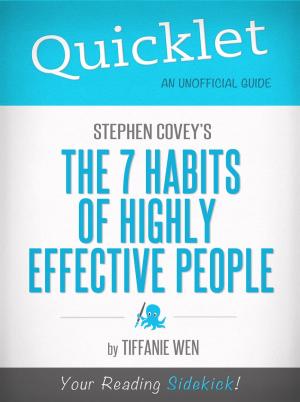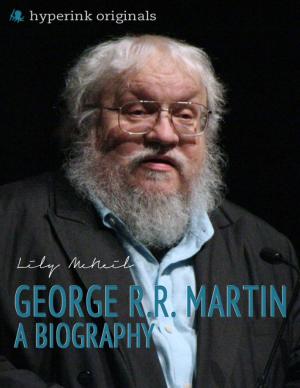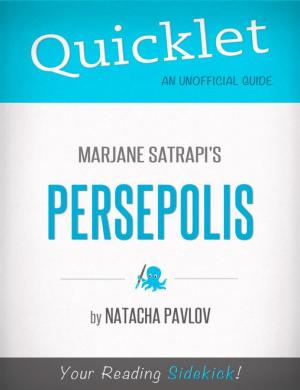Quicklet on Isabel Wilkerson's The Warmth of Other Suns: The Epic Story of America's Great Migration
Nonfiction, History, Americas, United States, 20th Century, Reference & Language, Study Aids| Author: | Taryn Nakamura | ISBN: | 9781614643548 |
| Publisher: | Hyperink | Publication: | March 26, 2012 |
| Imprint: | Language: | English |
| Author: | Taryn Nakamura |
| ISBN: | 9781614643548 |
| Publisher: | Hyperink |
| Publication: | March 26, 2012 |
| Imprint: | |
| Language: | English |
ABOUT THE BOOK
Isabel Wilkersons The Warmth of Other Suns is truly a labor of love. It took 15 years to research and write, as she interviewed over 1,200 people. Wilkerson tracked down her subjects at churches, quilting clubs, funerals, family reunions, and others. After preliminary rounds of interviews, she narrowed her search down to 30 people, and then chose the three main subjects who appear in the book.
She was racing against the clock to collect as many stories as possible from the migrants, whose numbers were starting to dwindle. Her book even covers the funerals of both George Starling and Robert Pershing Foster.
In order to write her story in a heartfelt manner, Wilkerson recreated Robert Fosters exhausting drive from Louisiana to California. Dr. Foster drove through three states without rest because blacks werent welcome at any motels in those regions. Wilkersons trip was cut short by her parents, who insisted she stop before reaching dangerous levels of fatigue. At a particularly perilous tract of the drive, Wilkerson writes that her mother said, You know he must have been ready to cry right about here.
MEET THE AUTHOR
Taryn was born and raised in Hawaii. She recently returned home after receiving a B.A. in English at Yale University. As a writing concentrator at Yale, Taryn focused on fiction, but as a Hyperink writer, she has learned that nonfiction can also be fun. In her free time, she likes to run at walking pace, haunt libraries, and eat pickles.
EXCERPT FROM THE BOOK
Critics have put Isabel Wilkersons book on par with classics like Roots and The Grapes of Wrath. The Wall Street Journal writes, Ms. Wilkerson does for the Great Migration what John Steinback did for the Okies in his fiction masterpiece, The Grapes of Wrath; she humanizes history, giving it emotional and psychological depth. (The Great Northern Migration)
But Ms. Wilkersons piece deserves a category of its own. Her book goes beyond both traditional and oral history. She avoided the style of Studs Terkel, opting for a more cohesive narrative. (A Writers Long Journey to Trace the Great Migration)
Critics agree that Isabel Wilkersons book is both beautifully written and thoroughly researched. Articles in the New York Times, Wall Street Journal, and The New Yorker can attest to that. The books appearance on Best Book of the Year lists L.A. Times, The Washington Post, The New Yorker, The Economist, and more reflects the high quality of reporting.
Yet the critics diverge in their assessment of the ending of the book and our takeaway. As Kevin Boyle writes in his Chicago Tribune review, In the end, though, Wilkerson herself seems to blink, arguing that, despite the struggles she so beautifully describes, the Great Migration was nothing less than the fulfillment of the American Dream as the migrants themselves defined it.
ABOUT THE BOOK
Isabel Wilkersons The Warmth of Other Suns is truly a labor of love. It took 15 years to research and write, as she interviewed over 1,200 people. Wilkerson tracked down her subjects at churches, quilting clubs, funerals, family reunions, and others. After preliminary rounds of interviews, she narrowed her search down to 30 people, and then chose the three main subjects who appear in the book.
She was racing against the clock to collect as many stories as possible from the migrants, whose numbers were starting to dwindle. Her book even covers the funerals of both George Starling and Robert Pershing Foster.
In order to write her story in a heartfelt manner, Wilkerson recreated Robert Fosters exhausting drive from Louisiana to California. Dr. Foster drove through three states without rest because blacks werent welcome at any motels in those regions. Wilkersons trip was cut short by her parents, who insisted she stop before reaching dangerous levels of fatigue. At a particularly perilous tract of the drive, Wilkerson writes that her mother said, You know he must have been ready to cry right about here.
MEET THE AUTHOR
Taryn was born and raised in Hawaii. She recently returned home after receiving a B.A. in English at Yale University. As a writing concentrator at Yale, Taryn focused on fiction, but as a Hyperink writer, she has learned that nonfiction can also be fun. In her free time, she likes to run at walking pace, haunt libraries, and eat pickles.
EXCERPT FROM THE BOOK
Critics have put Isabel Wilkersons book on par with classics like Roots and The Grapes of Wrath. The Wall Street Journal writes, Ms. Wilkerson does for the Great Migration what John Steinback did for the Okies in his fiction masterpiece, The Grapes of Wrath; she humanizes history, giving it emotional and psychological depth. (The Great Northern Migration)
But Ms. Wilkersons piece deserves a category of its own. Her book goes beyond both traditional and oral history. She avoided the style of Studs Terkel, opting for a more cohesive narrative. (A Writers Long Journey to Trace the Great Migration)
Critics agree that Isabel Wilkersons book is both beautifully written and thoroughly researched. Articles in the New York Times, Wall Street Journal, and The New Yorker can attest to that. The books appearance on Best Book of the Year lists L.A. Times, The Washington Post, The New Yorker, The Economist, and more reflects the high quality of reporting.
Yet the critics diverge in their assessment of the ending of the book and our takeaway. As Kevin Boyle writes in his Chicago Tribune review, In the end, though, Wilkerson herself seems to blink, arguing that, despite the struggles she so beautifully describes, the Great Migration was nothing less than the fulfillment of the American Dream as the migrants themselves defined it.















